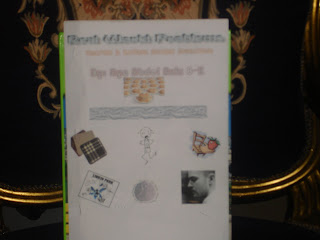
In quarter two we were assigned a project based on the sections of chapter 5: Rational Number Operations. For each section, we had to have at least 1 problem for each of the eight sections of Chapter 5.
- Section 1 Fractions with common denominators
- Section 2 Fractions with different denominators
- Section 3 Multiplying Fractions
- Section 4 Dividing Fractions
- Section 5 Fractions and Decimals
- Section 6 Adding and Subtracting Decimals
- Section 7 Multiplying and Dividing Decimals
- Section 8 Mean, Median, and Mode
Through these problems we had to use eight of the nine different strategies that are provided for us to solve a problem make a model, draw a diagram, guess check and revise, work backward, make a list or table, look for a pattern, break into parts, solve a simpler problem, and use a Venn Diagram. After using one strategy for each problem we then make a booklet with the problems in order and make sure the there is a title page, table of contents, and a cover page before the problems for the booklet.
The purpose of the project was for us to fully understand chapter 5 and for us to make our own problems using different types of strategies for different topics for the sections in chapter 5. Another reason was to fully understand how to make check a problem and to make sure that it is correct and does not have any silly mistakes such as 3+3=9, which then ruins the whole solution of the problem. One important point of the project was to organize our problems in an orderly fashion, so not to make it too confusing for the reader to read and evaluate. I did some strategies wrong for some certain problems, which then caused me to lose marks when my teacher was evaluating my paper.
What I learned from this project was how to write a problem using a certain strategy and concentrating on the way that strategy is written without making mistakes. Also, it helped me improve my basic math by adding, subtracting, multiplying, and dividing many basic numbers and fractions without the help of a calculator or writing it on a separate sheet of paper. What really helped me when it came to fractions was when I had long multiplication problems such as 9/20 * 8/20, I could easily multiply 8*9 to get my answer of 72 and 20*20 to get my answer of 72/400.
I could have learned differently if I checked over my problems more sufficiently and carefully then just simply turning it in without looking at it. Thinking up of sub-problems instead of the original first one that comes to mind is also a good example of learning differently. I also could have learned differently if I did a better job at the artistic part of the project and not have concentrated completely on the math part of the project.
This relates to my goal of organization because it was initial to have it because the problems all needed a special way of listing, ordering, and comparing in a way that is not confusing and easy to look at. Organization also helped how the project looked overall and how it differed to have good organization skills, a good neat project that its problems are easy to understand, from bad organization skills, a project with problems that are not as clear as they should be therefore resulting in a poor grade.
No comments:
Post a Comment